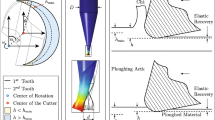Abstract
An accuracy of the chip thickness models used in the micro milling mechanics models directly affects the accuracy of the cutting force predictions. There are different chip thickness models derived from various kinematic analyses for the micro milling in the literature. This article presents an evaluation of chip thickness models for micro milling by examining their direct effects on predictions of cutting forces. Performances of four chip thickness models for micro milling existing in the literature are tested and compared with the experimental force measurements. Micro end milling experiments were conducted on an aerospace-grade aluminum alloy Al7050 for different feed rate values. The root mean square deviation and the coefficient of determination values between the estimated and measured micro milling forces are presented for the comparative evaluation of the major chip thickness models at various feed per tooth to tool diameter ratios.
Similar content being viewed by others
References
Dornfeld D, Min S, Takeuchi Y (2006) Recent advances in mechanical micromachining. CIRP Ann Manuf Technol 55:745–768
Wan M, Murat Kilic Z, Altintas Y (2014) Mechanics and dynamics of multifunctional tools. J Manuf Sci Eng 137:11–19
Wan M, Altintas Y (2014) Mechanics and dynamics of thread milling process. Int J Mach Tools Manuf 87:16–26
Armarego EJA, Deshpande NP (1991) Computerized end-milling force predictions with cutting models allowing for eccentricity and cutter deflections. CIRP Ann Manuf Technol 40:25–29
Leu MC, Lu F, Blackmore D (1998) Simulation of NC machining with cutter deflection by modelling deformed swept volumes. CIRP Ann Manuf Technol 47:441–446
Mamedov A, Layegh KSE, Lazoglu I (2015) Instantaneous tool deflection model for micro milling, Int J of Adv Manuf Technol, 79: 769-777
Altintas Y, Stepan G, Merdol D, Dombovari Z (2008) Chatter stability of milling in frequency and discrete time domain. CIRP J Manuf Sci Technol 1:35–44
Budak E, Tunç LT, Alan S, Özgüven HN (2012) Prediction of workpiece dynamics and its effects on chatter stability in milling. CIRP Ann Manuf Technol 61:339–342
Park SS, Rahnama R (2010) Robust chatter stability in micro-milling operations. CIRP Ann Manuf Technol 59:391–394
Jawahir IS, Brinksmeier E, M’Saoubi R, Aspinwall DK, Outeiro JC, Meyer D, Umbrello D, Jayal AD (2011) Surface integrity in material removal processes: recent advances. CIRP Ann Manuf Technol 60:603–626
Lazoglu I, Ulutan D, Alaca BE, Engin S, Kaftanoglu B (2008) An enhanced analytical model for residual stress prediction in machining. CIRP Ann Manuf Technol 57:81–84
Kersting P, Biermann D (2014) Modeling techniques for simulating workpiece deflections in NC milling. CIRP J Manuf Sci Technol 7:48–54
Denkena B, Böß V, Nespor D, Samp A (2011) Kinematic and stochastic surface topography of machined TiAl6V4-parts by means of ball nose end milling. Procedia Eng 19:81–87
Jin X, Altintas Y (2012) Prediction of micro-milling forces with finite element method. J Mater Process Technol 212:542–552
Park SS, Malekian M (2009) Mechanistic modeling and accurate measurement of micro end milling forces. CIRP Ann Manuf Technol 58:49–52
Malekian M, Park SS, Jun MBG (2009) Modeling of dynamic micro-milling cutting forces. Int J Mach Tools Manuf 49:586–598
Wang J, Zheng CM (2002) An analytical force model with shearing and ploughing mechanisms for end milling. Int J Mach Tools Manuf 42:761–771
Lucca D, Seo Y, Komanduri R (1993) Effect of tool edge geometry on energy dissipation in ultraprecision machining. CIRP Ann Manuf Technol 42:83–86
Martellotti M (1941) An analysis of milling process. ASME J Manuf Sci Eng 63:677–700
Bao W (2000) Modeling micro-end-milling operations. Part I: analytical cutting force model. Int J Mach Tools Manuf 40:2155–2173
Bao WY, Tansel IN (2000) Modeling micro end milling operations . Part II : tool run-out. Int J Mach Tools Manuf 40:2175–2192
Li HZ, Liu K, Li XP (2001) A new method for determining the undeformed chip thickness in milling. J Mater Process Technol 113:378–384
Li XP, Li HZ (2004) Theoretical modelling of cutting forces in helical end milling with cutter runout. Int J Mech Sci 46:1399–1414
Kang YH, Zheng CM (2013) Mathematical modelling of chip thickness in micro-end- milling: a Fourier modelling. Appl Math Model 37:4208–4223
Wang ZG, Rahman M, Wong YS, Neo KS, Sun J (2016) Geometrical Modeling for Micro End Milling Process, Proceeding of the First International Conference on Precision Engineering and Micro/Nano Technology in Asia 131–5
Altintas Y (2012) Manufacturing automation, metal cutting mechanics, machine tool vibrations and CNC design, 2nd edn. Cambridge University Press
Author information
Authors and Affiliations
Corresponding author
Rights and permissions
About this article
Cite this article
Mamedov, A., Lazoglu, I. An evaluation of micro milling chip thickness models for the process mechanics. Int J Adv Manuf Technol 87, 1843–1849 (2016). https://doi.org/10.1007/s00170-016-8584-6
Received:
Accepted:
Published:
Issue Date:
DOI: https://doi.org/10.1007/s00170-016-8584-6



